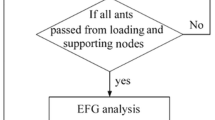Abstract
Standard Ant Colony Optimization (ACO) algorithm cannot provide an optimal topology for geometrically nonlinear structural problems. The reason is that the tangential stiffness matrix of low-density elements may become zero or negative, which leads to serious numerical instability problems, or the standard ACO algorithm cannot search the really efficient elements because of improper element search method. A modified ant colony optimization (MACO) algorithm is suggested to improve computational efficiency and suitability of standard ACO algorithm in topology optimization for these problems. A continuous variable, called the “Element Contribution Significance (ECS),” is introduced, which serves to replace the positions of ants in the standard ACO algorithm, and assess the importance of each element in the optimization process. The optimized topologies based on MACO algorithm are compared to those of the other topology methods. From the comparison, it is verified that MACO algorithm can successfully be applied to topology optimization for geometrically nonlinear structures, as well as provide stable and robust topologies.
Similar content being viewed by others
References
Bendsøe, M. P. and Kikuchi, N., “Generating Optimal Topologies in Structural Design using a Homogenization Method,” Computer Methods in Applied Mechanics and Engineering, Vol. 71, No. 2, pp. 197–224, 1988.
Mlejnek, H. P. and Schirrmacher, R., “An Engineer’s Approach to Optimal Material Distribution and Shape Finding,” Computer Methods in Applied Mechanics and Engineering, Vol. 106, No. 1, pp. 1–26, 1993.
Xie, Y. M. and Steven, G. P., “Evolutionary Structural Optimization,” Springer, pp. 121–131, 2010.
Xie, Y. M. and Steven, G. P., “A Simple Evolutionary Procedure for Structural Optimization,” Computers and Structures, Vol. 49, No. 5, pp. 885–896, 1993.
Querin, O. M., Steven, G. P., and Xie, Y. M., “Evolutionary Structural Optimisation (ESO) using a Bidirectional Algorithm,” Engineering Computations, Vol. 15, No. 8, pp. 1031–1048, 1998.
Liang, Q. Q. and Steven, G. P., “A Performance-Based Optimization Method for Topology Design of Continuum Structures with Mean Compliance Constraints,” Computer Methods in Applied Mechanics and Engineering, Vol. 191, No. 13, pp. 1471–1489, 2002.
Kim, H. J., Kim, B. Y., and Suh, M. W., “Development of a Topology Optimization Program Considering Density and Homogeni-Zation Methods,” Int. J. Precis. Eng. Manuf., Vol. 12, No. 2, pp. 303–312, 2011.
Sethian, J. A. and Wiegmann, A., “Structural Boundary Design Via Level Set and Immersed Interface Methods,” Journal of Computational Physics, Vol. 163, No. 2, pp. 489–528, 2000.
Belytschko, T., Xiao, S., and Parimi, C., “Topology Optimization with Implicit Functions and Regularization,” International Journal for Numerical Methods in Engineering, Vol. 57, No. 8, pp. 1177–1196, 2003.
Buhl, T., Pedersen, C. B., and Sigmund, O., “Stiffness Design of Geometrically Nonlinear Structures using Topology Optimization,” Structural and Multidisciplinary Optimization, Vol. 19, No. 2, pp. 93–104, 2000.
Pedersen, C. B., Buhl, T., and Sigmund, O., “Topology Synthesis of Large Displacement Compliant Mechanisms,” International Journal for Numerical Methods in Engineering, Vol. 50, No. 12, pp. 2683–2705, 2001.
Gea, H. C. and Luo, J., “Topology Optimization of Structures with Geometrical Nonlinearities,” Computers and Structures, Vol. 79, No. 20, pp. 1977–1985, 2001.
Cho, S. and Jung, H. S., “Design Sensitivity Analysis and Topology Optimization of Displacement-Loaded Non-Linear Structures,” Computer Methods in Applied Mechanics and Engineering, Vol. 192, No. 22, pp. 2539–2553, 2003.
Bruns, T. E. and Tortorelli, D. A., “An Element Removal and Reintroduction Strategy for the Topology Optimization of Structures and Compliant Mechanisms,” International journal for Numerical Methods in Engineering, Vol. 57, No. 10, pp. 1413–1430, 2003.
Yoon, G. H. and Kim, Y. Y., “Element Connectivity Parameterization for Topology Optimization of Geometrically Nonlinear Structures,” International Journal of Solids and Structures, Vol. 42, No. 7, pp. 1983–2009, 2005.
Yoon, G. H., “Maximizing the Fundamental Eigenfrequency of Geometrically Nonlinear Structures by Topology Optimization based on Element Connectivity Parameterization,” Computers and Structures, Vol. 88, No. 1, pp. 120–133, 2010.
Huang, X. and Xie, Y., “Topology Optimization of Nonlinear Structures under Displacement Loading,” Engineering Structures, Vol. 30, No. 7, pp. 2057–2068, 2008.
Huang, X. and Xie, M., “Evolutionary Topology Optimization of Continuum Structures: Methods and Applications,” John Wiley & Sons, pp. 121–150, 2010.
Luh, G. C. and Lin, C. Y., “Structural Topology Optimization using Ant Colony Optimization Algorithm,” Applied Soft Computing, Vol. 9, No. 4, pp. 1343–1353, 2009.
Kaveh, A., Hassani, B., Shojaee, S., and Tavakkoli, S., “Structural Topology Optimization using Ant Colony Methodology,” Engineering Structures, Vol. 30, No. 9, pp. 2559–2565, 2008.
Huang, X. and Xie, Y., “Convergent and Mesh-Independent Solutions for the Bi-Directional Evolutionary Structural Optimization Method,” Finite Elements in Analysis and Design, Vol. 43, No. 14, pp. 1039–1049, 2007.
Jung, D. and Gea, H. C., “Topology Optimization of Nonlinear Structures,” Finite Elements in Analysis and Design, Vol. 40, No. 11, pp. 1417–1427, 2004.
Dorigo, M., “Optimization, Learning and Natural Algorithms (in Italian),” Ph. D. Thesis, Department of Electronics and Information, Polytechnic of Milano, 1992.
Kosaka, I. and Swan, C. C., “A Symmetry Reduction Method for Continuum Structural Topology Optimization,” Computers and Structures, Vol. 70, No. 1, pp. 47–61, 1999.
Kaveh, A., Hassani, B., Shojaee, S., and Tavakkoli, S., “Structural Topology Optimization using Ant Colony Methodology,” Engineering Structures, Vol. 30, No. 9, pp. 2559–2565, 2008.
Shtovba, S. D., “Ant Algorithms: Theory and Applications,” Programming and Computer Software, Vol. 31, No. 4, pp. 167–178, 2005.
Author information
Authors and Affiliations
Corresponding author
Rights and permissions
About this article
Cite this article
Yoo, KS., Han, SY. Modified ant colony optimization for topology optimization of geometrically nonlinear structures. Int. J. Precis. Eng. Manuf. 15, 679–687 (2014). https://doi.org/10.1007/s12541-014-0387-9
Received:
Revised:
Accepted:
Published:
Issue Date:
DOI: https://doi.org/10.1007/s12541-014-0387-9



